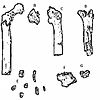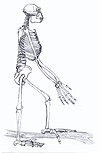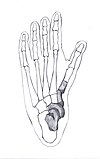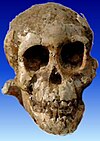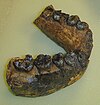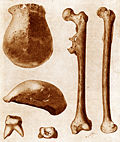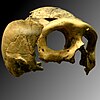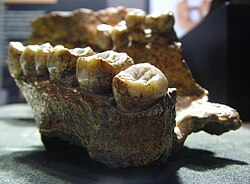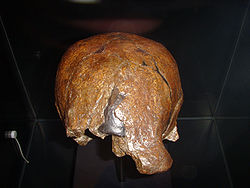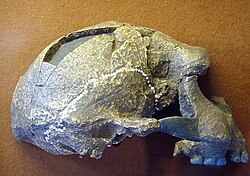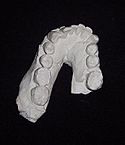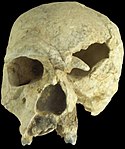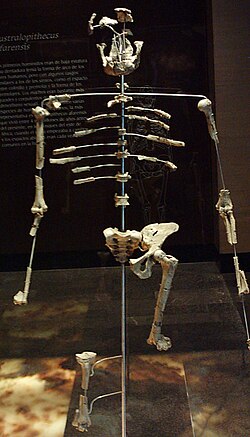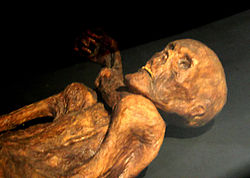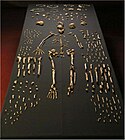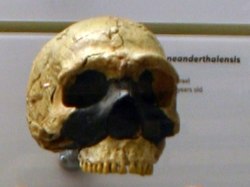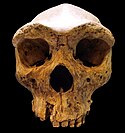Liste homininer Fossilien
Die folgenden Tabellen geben einen Überblick über einige bemerkenswerte Funde homininer Fossilien, die im Zusammenhang mit der Stammesgeschichte des Menschen und dem Prozess der Hominisation stehen. Da es tausende solcher Fossilien gibt, besteht hierbei kein Anspruch auf Vollständigkeit, vielmehr sollen die wesentlichsten Funde zusammengestellt werden.
Die Auflistung erfolgt anhand des Alters, welches durch radiometrische oder relative Datierung bestimmt wurde. Die Artbezeichnung entspricht dem momentanen Konsens. In Fällen, in denen keine wissenschaftliche Übereinkunft besteht, werden die übrigen Klassifikationen mit angegeben. Abgelehnte Bezeichnungen finden sich unter Umständen im Artikel zum jeweiligen Fossil. Nicht alle vorgestellten Fossilien werden als direkte Vorfahren von Homo sapiens angesehen. Sie stehen jedoch in engem Zusammenhang mit direkten Vorfahren und sind daher für das Studium der Abstammung von Bedeutung.
Älter als 2 Millionen Jahre
2 bis 1 Million Jahre
1 Million bis 100.000 Jahre
100.000 bis 50.000 Jahre
Jünger als 50.000 Jahre
| Abbildung | Name | Alter | Art | Datum der Entdeckung | Fundort | Erstbeschreibung |
|---|---|---|---|---|---|---|
| Le Moustier | 45 ka | Homo neanderthalensis | 1909 | Frankreich | Otto Hauser | |
 | Denisova-Mensch | 48–30 ka | ungeklärt; (vermutlich Schwestergruppe der Neandertaler) | 2010 | Russland, Tibet | |
 | Neandertal 1 | 40 ka | Homo neanderthalensis (Holotypus) | 1856 | Neandertal, Deutschland | Johann Carl Fuhlrott |
 | Spy I | 42 ka | Homo neanderthalensis | 1886 | Grotte de Spy, Jemeppe-sur-Sambre, Belgien | Marcel de Puydt, Max Lohest |
 | Spy II | 42 ka | Homo neanderthalensis | 1886 | Grotte de Spy, Jemeppe-sur-Sambre, Belgien | Marcel de Puydt, Max Lohest |
(c) James Maurice Bowler, CC BY-SA 3.0 | Mungo Man | 40 ka | Homo sapiens | 1974 | Australien | Jim Bowler |
| Mungo Lady | 40 ka | Homo sapiens | 1969 | Australien | Jim Bowler | |
| Qafzeh VI | Qafzeh 6 | Homo sapiens | Qafzeh-Höhle | |||
| Abb. des Unterkiefer-Fragments | Tianyuan 1 | 40 ka | Homo sapiens | 2003 | VR China | Hong Shang et al. |
 | Hofmeyr-Schädel | 36 ka | Homo sapiens | 1952 | Südafrika | |
 | Cro-Magnon 1 | 30 ka | Homo sapiens | 1868 | Frankreich | Édouard Lartet |
| Predmosti 3 | Predmost 3 | Homo sapiens | ||||
| Afalou 13 | ||||||
| Wadi Kubbaniya | ||||||
| Wadi Halfa 25 | ||||||
| Minatogawa 1 | Minatogawa 1 | 18–16 ka | Homo sapiens | 1970 | Japan | |
| Tandou | ||||||
| Kow Swamp 1 | Kow Swamp 1–22 | 13–9 ka | Homo sapiens | 1968 | Australien | A.G. Thorne |
| Wadjak 1 | 12–10 ka | Homo sapiens | 1888 | Indonesien | Eugène Dubois | |
| SDM 16704 (Del Mar Man) | 11,3 ± 1,2 ka[7] | Homo sapiens | USA (Kalifornien) | |||
 | Combe Capelle (Grab) | 9 ka (Neudatierung 2011!) | Homo sapiens | 1909 | Combe Capelle, Frankreich | Otto Hauser |
| Kennewick-Mann | 9,3 ka | Homo sapiens | 1996 | Kennewick, USA | James C. Chatters | |
| Lothagam 4b (Lo 4b) | 7,5 ka | Homo sapiens | 1965–1975 | Kenia | ||
 | Ötzi („Mann vom Tisenjoch“) | 5,3 ka | Homo sapiens | 1991 | Ötztaler Alpen (zwischen Österreich und Italien) | Helmut und Erika Simon |
 | Tepexpan-Mensch | 5 ka | Homo sapiens | 1947 | Mexiko | H. de Terra |
| Cerro Sota 2[8] | 3,7 ka (BP) | Homo sapiens | 1936 | Chile | Junius Bird | |
| Homo sapiens balangodensis | ?? | Homo sapiens | 1969 | Sri Lanka | P. E. P. Deraniyagala |
Abkürzungen im Fossilienverzeichnis
- AL – Afar Locality, Äthiopien
- ARA-VP – Aramis-Vertebrate Paleontology, Äthiopien
- AT – Atapuerca
- BAR – Baringo County, Kenia (Fundstätte Lukeino in den Tugen Hills)
- BEL – Belohdelie, Äthiopien (Middle Awash study area)
- BK – Blimbing Kulon, Java, Indonesien
- BK – Bell’s Korongo, Olduvai-Schlucht
- BOD-VP – Bodo D’Ar-Vertebrate Paleontology, Äthiopien (Middle Awash study area)
- BOU-VP – Bouri Vertebrate Paleontology, Äthiopien
- CGM – Cairo Geology Museum (heute: Ägyptisches Geologisches Museum)
- DIK – Dikika, Äthiopien
- DNH – Drimolen, Südafrika
- ER – East Rudolf (=Rudolfsee [heute:Turkana-See], Ostufer), Kenia
- GDA – Gondolin, Südafrika
- IVPP – Institute of Vertebrate Paleontology and Paleoanthropology of the Chinese Academy of Sciences
- KB – Kromdraai, Südafrika
- KGA – Konso-Gardula, Äthiopien
- KNM-BK – Kenia Nationalmuseum-Baringo Kapthurin (Kapthurin-Formation, Tugen Hills, Baringo District)
- KNM-ER – Kenia Nationalmuseum-East Rudolf (=Rudolfsee [heute:Turkana-See], Ostufer)
- KNM-WT – Kenia Nationalmuseum-Westufer Turkana-See
- KP – Kanapoi, Kenia
- KT – Koro Toro, Tschad
- OH – Olduvai Hominid, Tansania
- RC – Malema, Malawi-Rift
- SK, SKW, SKX – Swartkrans, Südafrika
- Sts, Stw, SE – Sterkfontein, Südafrika
- TM – Transvaal Museum, Südafrika
- TM – Toros-Menalla, Tschad
- UR – Uraha, Malawi
- WT – Westufer Turkana-See, Kenia
Siehe auch
- Kategorie:Fundstätte homininer Fossilien
- Wiege der Menschheit
Quellen
- Ian Tattersall, Jeffery Schwartz: Extinct Humans. Westview Press, Boulder (Colorado, USA) 2000, ISBN 0-8133-3482-9.
- Clark Spencer Larsen, Robert M. Matter, Daniel L. Gebo: Human Origins: the fossil record. Waveland Press, Prospect Heights (Illinois, USA), ISBN 0-88133-575-4.
- Smithsonian Human Origins Program. Abgerufen am 29. August 2006.
- Prominent Hominid Fossils. Abgerufen am 31. August 2006.
Belege
- ↑ Yohannes Haile-Selassie et al.: An early Australopithecus afarensis postcranium from Woranso-Mille, Ethiopia. In: PNAS. Band 107, Nr. 27, 2010, S. 12121–12126, doi:10.1073/pnas.1004527107
- ↑ W. H. Kimbel et al.: Late Pliocene Homo and Oldowan Tools from the Hadar Formation (Kada Hadar Member), Ethiopia. In: Journal of Human Evolution, Band 31, Nr. 6, 1996, S. 549–561, doi:10.1006/jhev.1996.0079
- ↑ Fossiler, fragmentierter Schädel in drei Teilen.
- ↑ M. H. Day, M. D. Leakey und C. Magori: A new hominid fossil skull (L.H. 18) from the Ngaloba Beds, Laetoli, northern Tanzania. In: Nature. Band 284, 1980, S. 55–56, doi:10.1038/284055a0
- ↑ Christopher J. Bae: The "Muddle in the Middle" (~400 ka – ~100 ka). Kapitel 4 in: Christopher J. Bae: The Paleoanthropology of Eastern Asia. University of Hawaii Press, 2024, S. 95–131, doi:10.1515/9780824898106
- ↑ Christopher J. Bae und Xiujie Wu: Making sense of eastern Asian Late Quaternary hominin variability. In: Nature Communications. Band 15 (1), S. 9479, doi:10.1038/s41467-024-53918-7
- ↑ doi:10.1017/S0033822200005981, Volltext
- ↑ doi:10.4067/S0718-22442010000200009 = MAGALLANIA, (Chile), 2010. Vol. 38(2):133-149
Auf dieser Seite verwendete Medien
Autor/Urheber: Ryan Somma, Lizenz: CC BY-SA 2.0
Homo floresiensis (the "Hobbit")
Autor/Urheber: Claire Houck from New York City, USA, Lizenz: CC BY-SA 2.0
Turkana Boy
Autor/Urheber: Jlorenz1, Lizenz: CC BY-SA 3.0
Selam (Australopithecus afarensis) or DIK 1-1
Autor/Urheber: Nachosan, Lizenz: CC BY-SA 4.0
KNM-KP 29281. Mandible of Australopithecus anamensis. Cast at the Museo Nacional de Ciencias Naturales in Madrid (Spain)
Autor/Urheber: Tobias Fluegel, Lizenz: CC BY-SA 3.0
Fußknochen von "Little Foot"(Stw 573 sceleton of Australopithecus) aus Südafrika. Eigene Zeichnung nach Abb. aus "Science" Magazin vom 28 Juli 1995.
Autor/Urheber: Dr. Günter Bechly, Lizenz: CC BY-SA 3.0
Schädel des fossilen Homo sapiens sapiens aus dem Epipaläolithikum von Combe Capelle
Autor/Urheber: Thilo Parg, Lizenz: CC BY-SA 4.0
La Ferrassie 1, eines der vollständigsten Skelette eines erwachsenen Neandertalers, entdeckt 1909 im Grand Abri de La Ferrassie. Original, Museé de l'Homme Paris, Ausstellung "Néandertal" 28 März 2018 bis 7. Januar 2019.
Herto skull, Homo sapiens idaltu
Autor/Urheber: Thilo Parg, Lizenz: CC BY-SA 4.0
Im Jahr 2000 in der Denisova-Höhle gefundener Molar Denisova 4. Original, ausgestellt in der Sonderausstellung "Le troisième Homme" im Musée national de Préhistoire in Les Eyzies-de-Tayac, Frankreich.
Autor/Urheber: Gerbil, Lizenz: CC BY-SA 3.0
Hominid Corridor Research Project (HCRP): fossiler Unterkiefer HCRP-UR 501 = Homo rudolfensis (Original), geborgen durch den deutschen Paläoanthropologen Friedemann Schrenk in Uraha, Malawi
Autor/Urheber: Gerbil, Lizenz: CC BY-SA 3.0
Palate (Oberkiefer und Gaumen) "Sangiran IV" (Original; 1,6 mya) of Homo erectus, collection Koenigswald (from 1939), Senckenberg-Museum, Frankfurt am Main, Germany
Autor/Urheber: Gerbil, Lizenz: CC BY-SA 3.0
Hinterhauptloch des Swanscombe-Schädels (Homo heidelbergensis), ca. 400.000 Jahre alt, Replika, Museum Tautavel (bei Perpignan), Frankreich
Autor/Urheber: Durova, Lizenz: CC BY-SA 3.0
Replica Paranthropus boisei (jr synonym Paranthropus boisei) skull. Cast from originals. Skull discovered by Mary Leakey, Olduvai Gorge, Tanzania 1959 - 1.75 million years old. Jaw discovered by Kamoya Kimeu 1964 - 1.5 million years old. Displayed at Museum of Man, San Diego, California.
Autor/Urheber: Ryan Somma from Occoquan, USA, Lizenz: CC BY-SA 2.0
Taken at the David H. Koch Hall of Human Origins at the Smithsonian Natural History Museum.
www.ideonexus.comAutor/Urheber: Nachosan, Lizenz: CC BY-SA 3.0
Mandíbula de Australopithecus afarensis, LH 4. Réplica
Original: Laetoli (Tanzania) 3,6 millones de años Museo Nacional de Dar Es Salaam, Tanzania Réplica: Colección privada (Madrid)
Exhibido en exposición temporal, "La cuna de la humanidad", en el Museo Arqueológico de Regional de MadridAutor/Urheber: Gerbil, Lizenz: CC BY-SA 3.0
Cranium D2700 from Dmanisi, Georgia (replica)
Autor/Urheber: Gerbil, Lizenz: CC BY-SA 3.0
Homo erectus KNM-ER 3883 (replica, Senckenberg Museum, Frankfurt am Main, Germany)
Autor/Urheber: Gerbil, Lizenz: CC BY-SA 3.0
Calvarium (Schaedeldach) "Sangiran II" (Original) of Homo erectus, collection Koenigswald, Senckenberg-Museum, Frankfurt am Main, Germany
Autor/Urheber: Didier Descouens, Lizenz: CC BY-SA 4.0
Cast of the Sahelanthropus tchadensis holotype cranium TM 266-01-060-1, dubbed Toumaï, in facio-lateral view.
- Specimen of the previous Molecular Anthropology and Imaging Synthesis Laboratory of the University of Toulouse 3 (with the French National Centre for Scientific Research (CNRS) and the University of Strasbourg) now the Centre for Anthropobiology and Genomics of Toulouse.
- Size: 182,5 X 105 X 97 mm
Autor/Urheber: Thilo Parg, Lizenz: CC BY-SA 4.0
Schädel und Unterkiefer Cro-Magnon 1, ausgestellt im Musée de l'Homme in Paris.
Autor/Urheber: Ryan Somma from Occoquan, USA, Lizenz: CC BY-SA 2.0
Bodo, Homo heidelbergensis. Taken at the David H. Koch Hall of Human Origins at the Smithsonian Natural History Museum.
The caption next to the skull reads:
"Bodo
Middle Awash, Ethiopia
About 600,000 years old
Cast"
Autor/Urheber: Gerbil, Lizenz: CC BY-SA 3.0
Fossil Sangiran 17 (= Pithecanthropus VIII); Replikat, Museum Tautavel, Frankreich
Autor/Urheber: Matt Celeskey, Lizenz: CC BY 3.0
Maxilla AL_200-1 of Australopithecus afarensis from Ethiopia
Autor/Urheber: Ryan Somma from Occoquan, USA, Lizenz: CC BY-SA 2.0
Tepexpan 1
- Site: Tepexpan, Mexico
- Year of Discovery: 1947
- Discovered by: H. de Terra
- Age: About 4,700 years old
- Species: Homo sapiens
Autor/Urheber: Photo by Brett Eloff. Courtesy Profberger and Wits University who release it under the terms below., Lizenz: CC BY-SA 4.0
The cranium of Malapa hominid 1 (MH1) from South Africa, named "Karabo". The combined fossil remains of this juvenile male is designated as the holotype for Australopithecus sediba.
Autor/Urheber: Didier Descouens, Lizenz: CC BY-SA 4.0
Cast in three parts: endocranium, face and mandible, of a 2.1 million year old Australopithecus africanus specimen so-called Taung child, discovered in South Africa.
Collection of the University of the Witwatersrand (Evolutionary Studies Institute), Johannesburg, South Africa. Sterkfontein cave, hominid fossil
(c) Scottaylor in der Wikipedia auf Englisch, CC BY 3.0
Cast replica of OH 7, the type specimen of Homo habilis.
Autor/Urheber: Gerbil, Lizenz: CC BY-SA 3.0
Unterkiefer von Mauer: Typusexemplar von Homo heidelbergensis (Replika); Museum Mauer
(c) José-Manuel Benito Álvarez, CC BY-SA 2.5
Cranium 5 is one of the most important discoveries in the Sima de los Huesos, Atapuerca (Spain). The mandible of this cranium appeared, nearly intact, some years after its find, close to the same location.
Autor/Urheber: Adam Foster, Lizenz: CC BY 2.0
Homo neanderthalensis Saccopastore I Rome, Italy About 130,000-100,000 years old
CastAutor/Urheber: GuillaumeG, Lizenz: CC BY-SA 4.0
Reproduction du crâne de Twiggy (OH 24). Musée des Civilisations Noires de Dakar (Sénégal).
(c) I, NobbiP, CC BY-SA 3.0
Homo steinheimensis (deutsche wikipedia) 250.000 Jahre alt (Abguss vom Originalschädel, Urmenschmuseum Steinheim)
Autor/Urheber: Nachosan, Lizenz: CC BY-SA 3.0
Cráneo de Ngaloba, Homo sapiens, LH 18. Réplica
Original: Laetoli (Tanzania) 120.000 - 200.000 años Museo Nacional de Dar Es Salaam, Tanzania Réplica: Instituto de Evolución en África
Exhibido en exposición temporal, "La cuna de la humanidad", en el Museo Arqueológico de Regional de MadridAutor/Urheber: Gerbil, Lizenz: CC BY-SA 3.0
Homo erectus KNM-ER 3733 (replica, Senckenberg Museum, Frankfurt am Main, Germany)
Autor/Urheber: Ryan Somma from Occoquan, USA, Lizenz: CC BY-SA 2.0
Taken at the David H. Koch Hall of Human Origins at the Smithsonian Natural History Museum.
www.ideonexus.comVista lateral del cráneo Gibraltar 1, encontrado en 1848 y descrita 20 años después como Homo neanderthalensis.
Autor/Urheber: 120, Lizenz: CC BY-SA 3.0
reconstruction of Ötzi mummy as shown in Prehistory Museum of Quinson, Alpes-de-Haute-Provence, France
Autor/Urheber: Nachosan, Lizenz: CC BY-SA 3.0
Fósil Nduru. Homo rhodesiensis. Réplica Exhibido en exposición temporal, "La cuna de la humanidad", en el Museo Arqueológico de Regional de Madrid
Autor/Urheber: Hans Weingartz, Lizenz: CC BY-SA 2.0 de
Schädeldecke des 1856 gefundenen Neandertalers
- Ort der Aufnahme: Rheinisches Landesmuseum Bonn
- Aufnahme: 10. September 2005
- Url: http://www.pass-weingartz.de/hw.htm
Autor/Urheber: kevinzim, Lizenz: CC BY 2.0
skull Peking Man, lighting was disasterously wrong, and this is what happened when I zapped up the contrast
original fossils of Pithecanthropus erectus (now Homo erectus) found in Java in 1891
Autor/Urheber: Lee Roger Berger research team, Lizenz: CC BY 4.0
Dinaledi skeletal specimens. The figure includes approximately all of the material incorporated in this diagnosis, including the holotype specimen, paratypes and referred material. These make up 737 partial or complete anatomical elements, many of which consist of several refitted specimens. Specimens not identified to element, such as non-diagnostic long bone or cranial fragments, and a subset of fragile specimens are not shown here. The ‘skeleton’ layout in the center of the photo is a composite of elements that represent multiple individuals. This view is foreshortened; the table upon which the bones are arranged is 120-cm wide for scale.
Autor/Urheber: Ryan Somma from Occoquan, USA, Lizenz: CC BY-SA 2.0
SK 847. Homo habilis sensu lato or Homo erectus. Taken at the David H. Koch Hall of Human Origins at the Smithsonian Natural History Museum.
www.ideonexus.comAutor/Urheber: Ryan Somma from Occoquan, USA, Lizenz: CC BY-SA 2.0
Taken at the David H. Koch Hall of Human Origins at the Smithsonian Natural History Museum.
www.ideonexus.comAutor/Urheber: LoKiLeCh, Lizenz: CC BY 3.0
Homo rudolfensis
KNM-ER-1470 (ca. 1,9 Mio.J.) Koobi Fora (Kenia) Schädel gefunden 1972 von Bernard Ngeneo, Gehirnvolumen 750 ccm. Einer der umstrittensten Urmenschenfunde
Hessisches Landesmuseum, DarmstadtAutor/Urheber: GuillaumeG, Lizenz: CC BY-SA 4.0
Reproduction du crâne de l'Homme de Kibish. Musée des Civilisations Noires de Dakar (Sénégal).
Autor/Urheber: Gunnar Creutz, Lizenz: CC BY-SA 4.0
Homo habilis (cast of skull) at Göteborgs Naturhistoriska Museum, Göteborg, Västra Götaland County, Sweden. This is a cast of the skull KNM-ER 1813.
Autor/Urheber: Luna04, Lizenz: CC BY 2.5
Homo neanderthalensis. Skull discovered in 1908 at La Chapelle-aux-Saints (France).
Autor/Urheber: Guérin Nicolas (messages), Lizenz: CC BY-SA 3.0
Muséum d'Anthropologie, campus universitaire d'Irchel, Université de Zurich (Suisse) : Paranthropus aethiopicus, reconstitution du crâne noir (numéro d'inventaire KNM WT 17000). Âge : - 2.5 millions d'années. Découverte : Lomekwi, basse vallée de l'Omo, Kenya.
Autor/Urheber: Wolfgang Sauber, Lizenz: CC BY-SA 4.0
The Ehringsdorf H skull cap, reassembled from ten pieces (H1 to H10).
Autor/Urheber: Ghedoghedo, Lizenz: CC BY-SA 4.0
Fossil of Homo neanderthalensis - Took the picture at MUSE, Trento
Autor/Urheber: Ryan Somma from Occoquan, USA, Lizenz: CC BY-SA 2.0
A replica of the Krapina 3 skull at the David H. Koch Hall of Human Origins, Smithsonian Natural History Museum.
www.ideonexus.comAutor/Urheber: Tim from Washington, D.C., United States of America, Lizenz: CC BY-SA 2.0
Cast of the "Laetoli footprints" -- the earliest known human footprints in the world, on display in the Hall of Human Origins in the Smithsonian Museum of Natural History in Washington, D.C.
These footprints are those of Australopithecus afarensis. The entire footprint trail is 88 feet long and includes impressions left by two early humans. They were made 3.6 million years ago in Laetoli, Tanzania, when A. afarensis walked through wet volcanic ash. Paleontologist Mary Leakey found them in 1976, but they were not identified until Paul Abell did so in 1978. There are 70 footprints in total.
Australopithecus afarensis is an extinct human ancestor that lived between 3.9 to 2.9 million years ago. It is more closely related to human beings that Australopithecus africanus, which also lived at about the same time. Australopithecus afarensis was discovered in the Afar region of Ethiopia (hence the name "afarensis") in November 1973. The genus name, "Australopithecus", comes from the Latin word australis (or "southern") and the Greek word pithekos ("ape").
The most famous find is a partial skeleton discovered on November 24, 1974. It was named named Lucy because the scientists who found it repeatedly played the song "Lucy in the Sky with Diamonds" in celebration.(c) Lucius, CC BY-SA 3.0
Orrorin tugenensis fossils.
- A: BAR 1002'00, left femur;
- B: BAR 1215'00, fragmentary right proximal femur;
- C: BAR 1003'00, proximal left femur;
- D: BAR 1004'00, right distal humerus;
- E: Teeth;
- F: BAR 1000'00, left mandibular fragment with M2–3;
- G: BAR 1000'00, right mandibular fragment with M3.
Autor/Urheber: Gerbil, Lizenz: CC BY-SA 3.0
Fossil Arago XXI = „Mensch von Tautavel“ = Homo erectus aus Tautavel, Frankreich (Replikat, Museum Tautavel)
Autor/Urheber: Gerbil, Lizenz: CC BY-SA 3.0
"Broken Hill Skull" aus Kabwe, Sambia. Der Schädel wurde (als Typusexemplar) zunächst Homo rhodesiensis benannt und später zu Homo erectus gestellt. Seit den 1990er-Jahren wird er von einem Teil der Forscher als afrikanische Variante von Homo heidelbergensis ausgewiesen, und gelegentlich wird er auch als "archaischer Homo sapiens" bezeichnet.
Autor/Urheber: Ditsong National Museum of Natural History , Lizenz: CC BY-SA 4.0
The original complete skull (without mandible) of a 1,8 million years old Paranthropus robustus (SK-48 Swartkrans (26°00'S 27°45'E), Gauteng,), discovered in South Africa . Collection of the Transvaal Museum, Northern Flagship Institute, Pretoria South Africa.
Autor/Urheber: Thilo Parg, Lizenz: CC BY-SA 4.0
Knochen und Zähne des Individuums Spy I aus der Grotte de Spy bei Jemeppe-sur-Sambre in Belgien. Replikate, ausgestellt im Espace de l’Homme de Spy - Centre d'interprétation.
Autor/Urheber: José Braga; Didier Descouens, Lizenz: CC BY-SA 4.0
Kompletter Original-Schädel (Unterkiefer und Oberkiefer-Zähne fehlen) der 2,1 Millionen Jahre alten Spezies Australopithecus africanus, Fundort Südafrika, bekannt unter dem Namen Mrs. Ples.
Sammlung des Transvaal Museums, Northern Flagship Institut, Pretoria, Südafrika. (Katalognummer STS 5, Sterkfontein-Höhle, hominides Fossil Nr. 5)
Autor/Urheber: DagdaMor, Lizenz: CC BY 4.0
right dentary of Homo erectus bilzingslebenensis (Bilzingsleben E7), discovered in 1999, Bilzingsleben, Thuringia, Germany, Middle Pleistocene, Lower Palaeolithic
Autor/Urheber: Thilo Parg, Lizenz: CC BY-SA 4.0
Knochen und Zähne des Individuums Spy II aus der Grotte de Spy bei Jemeppe-sur-Sambre in Belgien. Replikate, ausgestellt im Espace de l’Homme de Spy - Centre d'interprétation.
Autor/Urheber: Frederick E. Grine, Lizenz: CC BY-SA 3.0
Hofmeyr skull, Homo sapiens
Autor/Urheber: Hong Ao, Chun-Ru Liu, Andrew P. Roberts, Peng Zhang, and Xinwen Xu, Lizenz: CC BY-SA 4.0
Homo remains from Xujiayao, Shanxi, China
(a) Maxilla, (b) 3 molars, (c) three parietal fragments, (d) an occipital, (e) a mandible, and (f) a temporal.

